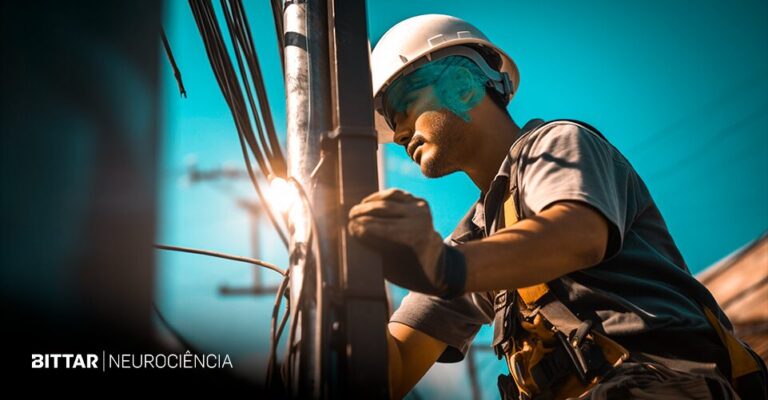According to a recent study, power line workers are more prone to making high-risk mistakes
Worker safety is paramount when it comes to the construction industry, especially in the electrical sector. A recent study led by Shiva Pooladvand and Sogand Hasanzadeh and published in the journal Automation in Construction examined the effects of time pressure and cognitive demand on the performance of electrical workers. The research found that such pressure and cognitive demand significantly increased the likelihood of mistakes among participants. Ultimately, these misconceptions about safety risks resulted in risky decisions and an overall decrease in safety performance.
The construction industry, particularly the electrical sector, faces substantial challenges in terms of occupational safety. Data point to it being one of the most dangerous fields for workers, with a high incidence of accidents and fatalities. Despite accounting for only 5.3% of the workforce in the United States, for instance, it was responsible for over 19% of fatal occupational incidents in 2019 – mostly caused by unsafe behaviors and worker mistakes.
Power line workers play a crucial role in installing and maintaining electrical systems in various construction contexts. Among other activities, they’re responsible for wiring buildings and lighting systems, connecting power sources, and ensuring the safety and functionality of electrical components. However, they also face significant risks, including electric shocks, arcs, and electrocution, which can result in serious injuries and even fatalities. Additionally, fire risks due to faulty wiring and improper use of electrical equipment are also a major concern.
To mitigate these dangers, it is essential for workers to follow strict safety protocols and use appropriate protective equipment. However, the study highlights the challenges they face in balancing workplace safety with constant pressure to increase productivity.
The experiment conducted by the study’s authors, Shiva Pooladvand and Sogand Hasanzadeh, involved a simulated electrical construction task in a mixed-reality environment to investigate the effects of safety interventions on worker performance under time pressure and cognitive demand. The results showed a clear correlation between these factors and the occurrence of mistakes, with a decrease in safety performance under more challenging conditions.
The study involved 30 healthy students from civil engineering, construction engineering and management, and construction management technology programs. In total, 22 were male and had an average of one and a half years of experience working in the construction industry.
The experimental task required participants to move three live power lines from an old pole to a new one without interrupting power in a suburban residential area that these lines supply. To complete it, students needed to move the lines and remove the insulator covers from the conductors. This is the type of task that power line workers might perform when repairing storm damage, for example. As it was unfeasible and ethically unacceptable to have students perform a task under real conditions, the authors built an immersive mixed-reality environment in which the activity was carried out.
Participants would carry out the task standing in the bucket of a truck, which simulated elevating them to the top of an electrical pole. However, they had to observe three different conditions during the exercise: firstly, complete it at their own pace; secondly, do it within a time limit (time pressure); thirdly, complete the task while simultaneously performing a working memory activity (cognitive demand). The study authors used Functional Near-Infrared Spectroscopy (fNIRS) to track participants’ brain activity while performing the exercise. fNIRS is a non-invasive neuroimaging technique that provides information about brain activity by measuring changes in cerebral blood flow and oxygenation, detecting near-infrared light absorption. You can check more information about this method here.
The authors monitored whether participants were able to complete the task without causing an electrical arc, if they were able to fulfill it within the defined time (in the time pressure condition) and how accurately they performed the working memory task (in the cognitive demand condition). Each participant completed the three exercises with 2-minute rest periods between them. The results showed that those who worked at their own pace succeeded in 85% of the cases. When time pressure was introduced, this percentage dropped to 73%, while they made mistakes in 27% of tasks. Under cognitive demand, participants made mistakes more than half the time: in 58% of tasks.
fNIRS data analysis showed an increased tendency for activity in brain regions being monitored as the task became more difficult. The same applies to individual variability in levels of brain activity, which tended to increase much more along with the difficulty. This was particularly evident in the motor cortex and right hemisphere brain regions. The higher variability may indicate that while brain activity was directly proportional to task difficulty in some participants, this may not have been the case in others.
“The results showed that workers failed to process surrounding information due to limited cognitive resources, and erroneously perceived potential risks under time pressure and increased mental demand. These cognitive failures then led to increased reliance on safety protections and risk-taking decisions, negatively impacting safety performance overall,” concluded the study authors.
The research provides valuable insight into how performance changes under time pressure or increased mental demand. However, it is important to note the study was conducted in a mixed-reality environment, where participants were fully aware that it was not real – which may have affected their risk acceptance levels. Results in real-world environments might not be the same.




